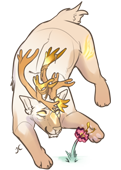Tokopedia
Peryton
Description:
A strange mix of cervid and bird, Perytons can be seen soaring through the caverns of Sikatou or grazing on the mushrooms found on ledges high up the walls.
They are varied in appearance, with multiple different combinations of the base creatures possible.
Flashes of gold and glowing golden eyes are found commonly across all the varieties.
Similarly to birds, males come in more vibrant colors, displaying antlers that can grow into unique shapes. Perytons frequently maintain their antlers, as it is an important asset for mateship. The most gracious, elegant-looking males are more likely to find a mate. Unfortunately, beauty sometimes comes with a price, as larger antlers can make it more difficult to balance their weight and their intricate shapes can be less efficient for defense.
Lore:
Perytons are extremely elusive and rare to observe, so they are commonly believed to come to the aid of hunters during times of scarcity and hardship. When one sees a Peryton, they are encouraged to follow it as their sightings indicate the presence of nearby prey, which the Peryton are claimed to lead to.
Perytons are more commonly sought and even prayed for in areas where prey is scarce, such as during winter seasons. It is not uncommon to find shrines dedicated to Perytons in lands where the climate is harsh. Candles can be lit to honor them, with a wish that they may lead the people to a source of bounty prey.
Their antlers are said to take on the nature of the Peryton's diet. The varied and fantastic environment in Sikatou's cavern where Perytons inhabit provided the species ample paths to grow and develop. There are currently only a few dozen confirmed usage of antlers of Perytons that feed on specific fungus in a remote location of the mushroom forest, mostly medicinal. Studies are actively under way to examine other properties of the antlers.
Behaviour:
Perytons have an immense craving for the salts and minerals held in the cavern walls and stone formations. They can sometimes be seen balancing high on the walls with their sure-footed fawns, where they lick the salts and mineral-rich waters that trickle into their home. Peryton fawns may not be able to fly immediately but they can scale nearly sheer rock faces within minutes of birth.
They usually form small groups of three to five individuals, but they can join other Perytons when going out in the open, relying on the safety of a larger group. Once they retreat to the caverns, they follow their own paths. Male Perytons tend to have a more solitary life, while the females often enjoy the company of their young as well as other females.
Peryton are not known for their beautiful song, but their range includes the low bellows of elk and the high trill of songbird. Some wanderers have mistaken the sound for an instrument, losing themselves in the wilderness only to be met face to face with a Peryton in rut - an incredibly dangerous situation to be in.
Domestication:There have been attempts at domestication and a few successful reports. Perytons have a docile and caring nature, but they can be skittish if they feel any threats. They avoid going too close to danger, as they are not exactly well-versed in quick escapes. They cannot run fast, and they move rather clumsily on land. Their only method of getting away is through flying. Once they are in the air, they are relatively free from danger, but taking flight consumes time and energy.
Lifecycle:
Peryton’s mating season is during mid winter, it is when they become more vocal and unpredictable. Their ritual of courtship can last hours, sometimes even days for the younger and more inexperienced males. This can be either due to constant rejection of the female, or when there is competition. Perytons will avoid fights if they can, but sometimes it is inevitable. Clashing antlers with another male is dangerous, even though the risk of injuries is actually low. If a Peryton’s antler breaks, he will no longer be able to find a mate until it grows back. It is a sign of defeat and shame worse than simply backing off from the fight.
Their gestation period lasts for around five months, with their younglings being born in summer. Perytons give birth to one fawn only; cases of twins are extremely rare and associated with great prosperity.
Parents are very caring of their young, so keeping distance from a mother with her youngling is the wisest choice. She will give everything to defend her young, even if it compromises her own survival.
Creature compiled from contributions by CH-Travels, Dragonandgold, Lachtaube, Viscella, xfrostfall and the Tokotas Admin Team.Creature art by FantasyToArtt

